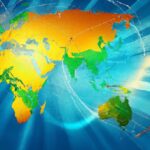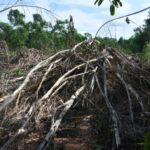Deforestation results from agricultural expansion, logging operations, infrastructure development, and urbanization. In many regions, the demand for land for crop cultivation leads to extensive forest clearance. Logging activities, both legal and illegal, contribute significantly to forest loss globally. Infrastructure projects, such as roads and dams, can fragment and degrade forests. The expansion of cities and towns causes deforestation as habitats are cleared for settlement. Moreover, wildfires, often exacerbated by human activities like land clearing and climate change, destroy vast areas of forests. These varied factors interplay to drive deforestation, impacting biodiversity, climate, and local communities.
Table of Contents
(Deforestation | Causes, Effects & Solutions | Video for Kids)
Deforestation is primarily caused by agricultural expansion, logging for timber, and infrastructure development. The demand for land to cultivate crops or rear livestock often leads to clearing forests. Additionally, logging for commercial purposes contributes significantly to tree loss. Roads, dams, and urbanization projects require clearing large areas of forests, further accelerating deforestation. Illegal logging and unsustainable forestry practices also play a role. Forests are vital for maintaining biodiversity and regulating the climate, making deforestation a grave environmental concern. Loss of forests results in habitat destruction and threatens numerous plant and animal species with extinction. Moreover, deforestation exacerbates climate change by releasing stored carbon back into the atmosphere. Indigenous communities depend on forests for their livelihoods, making deforestation a socio-economic issue as well. Addressing deforestation requires sustainable land-use practices, stricter regulations on logging, and promoting reforestation efforts. Public awareness and consumer choices can also influence the preservation of forests. Global collaboration and government policies are essential to combat deforestation and protect our planet’s vital forests.
Agriculture expansion
Agriculture expansion is a significant contributor to deforestation worldwide, fueled by the growing demand for food and other agricultural products. The need to clear land for farming activities such as livestock grazing and crop cultivation has led to the destruction of vast stretches of forests. This expansion often involves large-scale commercial agriculture, which prioritizes profit over environmental conservation. As a result, many forests are being cleared at an alarming rate, leading to loss of biodiversity and disruption of delicate ecosystems.
Small-scale farmers also play a role in agricultural expansion, as they seek to increase their income by expanding their farming activities. In many cases, these farmers do not have access to sustainable agricultural practices and resort to clearing forests to make way for their crops or livestock. Additionally, the growing global population puts pressure on farmers to produce more food, leading to further expansion of agricultural land.
Deforestation caused by agriculture expansion has far-reaching consequences for the environment. It results in the release of large amounts of carbon dioxide into the atmosphere, contributing to climate change. The loss of forests also reduces the Earth’s ability to absorb carbon dioxide, exacerbating the problem further. Furthermore, deforestation leads to soil erosion, loss of water sources, and increased vulnerability to natural disasters such as floods and landslides.
Efforts to address the issue of agriculture expansion and deforestation include promoting sustainable farming practices, such as agroforestry and organic agriculture. These practices aim to increase agricultural productivity while minimizing the impact on forests and other natural habitats. Government policies and regulations can also help curb deforestation by promoting reforestation, protecting indigenous lands, and enforcing laws against illegal logging and land clearing.
It is crucial for individuals, governments, and organizations to work together to address the root causes of deforestation and promote sustainable land use practices. By raising awareness about the impacts of agriculture expansion on forests and implementing solutions to mitigate these impacts, we can protect our precious natural resources for future generations.
Climate change
Climate change is intricately linked to deforestation, amplifying its destructive impact on the environment. As forests are cleared, carbon dioxide is released into the atmosphere, contributing significantly to global warming. This results in more frequent and intense extreme weather events, such as droughts, floods, and heatwaves.
The loss of tree cover diminishes the Earth’s capacity to absorb CO2, exacerbating the greenhouse effect. This vicious cycle of deforestation and climate change forms a deadly feedback loop, intensifying environmental degradation. Rising temperatures also disrupt ecosystems, endangering plant and animal species that depend on stable climate conditions.
Deforestation decreases biodiversity, making ecosystems more vulnerable to collapse. This loss of biodiversity not only affects wildlife but also threatens human livelihoods that rely on healthy ecosystems for food, medicine, and resources. Additionally, deforestation contributes to soil erosion, leading to degraded land that is less productive for agriculture.
The impacts of deforestation on climate change are far-reaching, transcending geographic boundaries and affecting people worldwide. Forests play a crucial role in regulating the Earth’s climate by absorbing and storing carbon, helping to maintain a stable climate. Protecting and restoring forests is essential for mitigating climate change and reducing its devastating consequences.
Addressing the root causes of deforestation, such as unsustainable logging, agricultural expansion, and land clearing for infrastructure development, is imperative in the fight against climate change. By promoting sustainable land use practices and supporting forest conservation efforts, we can help preserve vital ecosystems and reduce carbon emissions.
Individual actions, such as reducing personal consumption of products linked to deforestation, advocating for forest protection policies, and supporting reforestation initiatives, can also contribute to combatting climate change. It is crucial for individuals, communities, governments, and organizations to work together towards a greener and more sustainable future, where forests thrive, and the planet is safeguarded for future generations.
Impact on wildlife
Deforestation has significant consequences for wildlife. The destruction of forests results in habitat loss for countless species. Many animals rely on forests for shelter, food, and breeding grounds. As trees are cut down, these animals lose their homes and sources of sustenance. This disruption can lead to a decline in population numbers and even extinction for some species. Additionally, deforestation fragments habitats, isolating populations and reducing genetic diversity. This fragmentation makes it challenging for animals to find mates and can lead to inbreeding, further threatening their survival. The physical act of clearing forests also poses a direct threat to wildlife. Machinery used in deforestation can injure or kill animals that call the forests home. Furthermore, deforestation contributes to climate change, which has cascading effects on wildlife. Changes in temperature and weather patterns can disrupt natural cycles and migration patterns. This disruption can have devastating effects on ecosystems and the species within them. Some animals may be unable to adapt quickly enough to survive in changing conditions. The loss of biodiversity resulting from deforestation weakens ecosystems and can lead to a collapse of interconnected relationships. This can result in a domino effect, where the decline of one species triggers the decline of others. The impact of deforestation on wildlife extends beyond individual species. It can also affect entire ecosystems and the services they provide. Forests play a crucial role in regulating water cycles, preventing erosion, and storing carbon. The loss of forests disrupts these essential functions, further endangering wildlife and humans alike. Recognizing the link between deforestation and wildlife loss is crucial for implementing effective conservation measures. Conservation efforts must focus on preserving and restoring forest habitats to protect biodiversity. By addressing the root causes of deforestation and promoting sustainable land use practices, we can mitigate the impact on wildlife and safeguard the intricate web of life that depends on forests. Ultimately, the preservation of forests is essential for ensuring the survival of countless species and maintaining the health of our planet.
(Climate 101: Deforestation | National Geographic)
Logging
Logging, a significant cause of deforestation, involves the cutting down of trees for various purposes. This destructive practice contributes to the loss of valuable forest ecosystems worldwide. Trees are typically felled for timber, paper production, and commercial purposes, leading to widespread environmental degradation. The machinery used in logging operations further exacerbates the negative impact on the natural habitat.
Forests that are logged may never fully recover their original state due to the destruction of intricate ecosystems that support diverse plant and animal species. This loss of biodiversity has far-reaching consequences, impacting the delicate balance of the environment. Additionally, clearing forests through logging releases stored carbon dioxide into the atmosphere, exacerbating climate change.
Illegal logging poses a particularly significant threat, with vast areas of forests being plundered without regard for sustainable practices or conservation efforts. In many cases, indigenous communities and local inhabitants who rely on forests for their livelihoods are displaced or marginalized by large logging corporations seeking to exploit natural resources for profit. The social implications of logging extend beyond environmental considerations, affecting communities and traditional ways of life.
Efforts to combat deforestation caused by logging include establishing protected areas, promoting sustainable forestry practices, and enforcing regulations to prevent illegal logging activities. Reforestation initiatives aim to restore degraded landscapes and promote the regrowth of vital forest ecosystems. By raising awareness about the impacts of logging and advocating for responsible land management, individuals can contribute to preserving forests for future generations.
In conclusion, the issue of logging as a driver of deforestation demands urgent attention and concerted efforts to protect the world’s remaining forests. By addressing the root causes of logging, implementing sustainable practices, and supporting conservation initiatives, we can mitigate the destructive impact of this practice and safeguard the invaluable benefits that forests provide to the planet and its inhabitants.
Urbanization
Urbanization is a significant factor in the causes of deforestation. As cities expand, demand for land increases. This leads to the clearing of forests to make way for infrastructure and housing. Rapid population growth in urban areas puts pressure on resources. Industries and businesses require more land, leading to deforestation. Urban development often does not prioritize sustainable practices. This results in unchecked clearing of forests for immediate economic gain. The construction of roads and buildings fragments forest ecosystems. This disrupts wildlife habitats and contributes to biodiversity loss. Urban areas generate large amounts of waste and pollution. Waste disposal leads to land degradation and water pollution. Deforestation exacerbates climate change by reducing carbon storage capacity. Trees play a crucial role in absorbing greenhouse gases. Urbanization disrupts this natural process, contributing to global warming. The loss of forest cover impacts local communities reliant on forest resources. Indigenous peoples and traditional forest dwellers are adversely affected. Deforestation due to urbanization threatens the livelihoods of these communities. Urban areas experience increased temperatures due to the heat island effect. Trees provide shade and help regulate urban microclimates. Their removal contributes to higher temperatures and decreased air quality. The social impacts of deforestation caused by urbanization are profound. Displacement of communities and loss of cultural heritage are common. Ensuring sustainable urban planning and development is crucial. Preserving green spaces within cities can help mitigate forest loss. Implementing policies to promote green infrastructure is essential. Encouraging urban forestry initiatives can offset the impact of urbanization on forests. Public awareness and participation are vital in addressing these issues. Sustainable urbanization practices can help protect forests and mitigate deforestation. Collaboration between government, businesses, and communities is key. By working together, we can minimize the impact of urbanization on forests. Promoting a balance between urban development and forest conservation is imperative. Together, we can create thriving and sustainable urban environments while preserving our precious forests.













